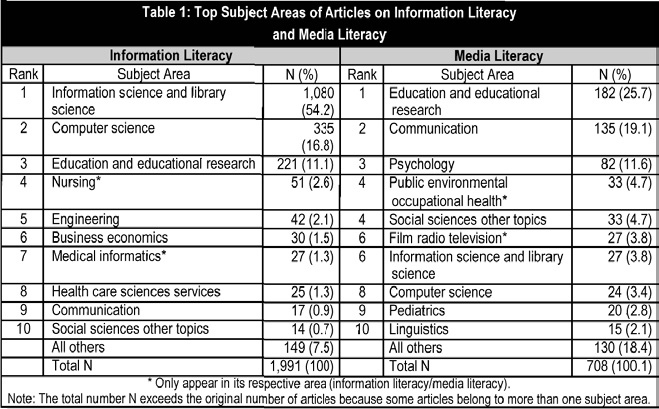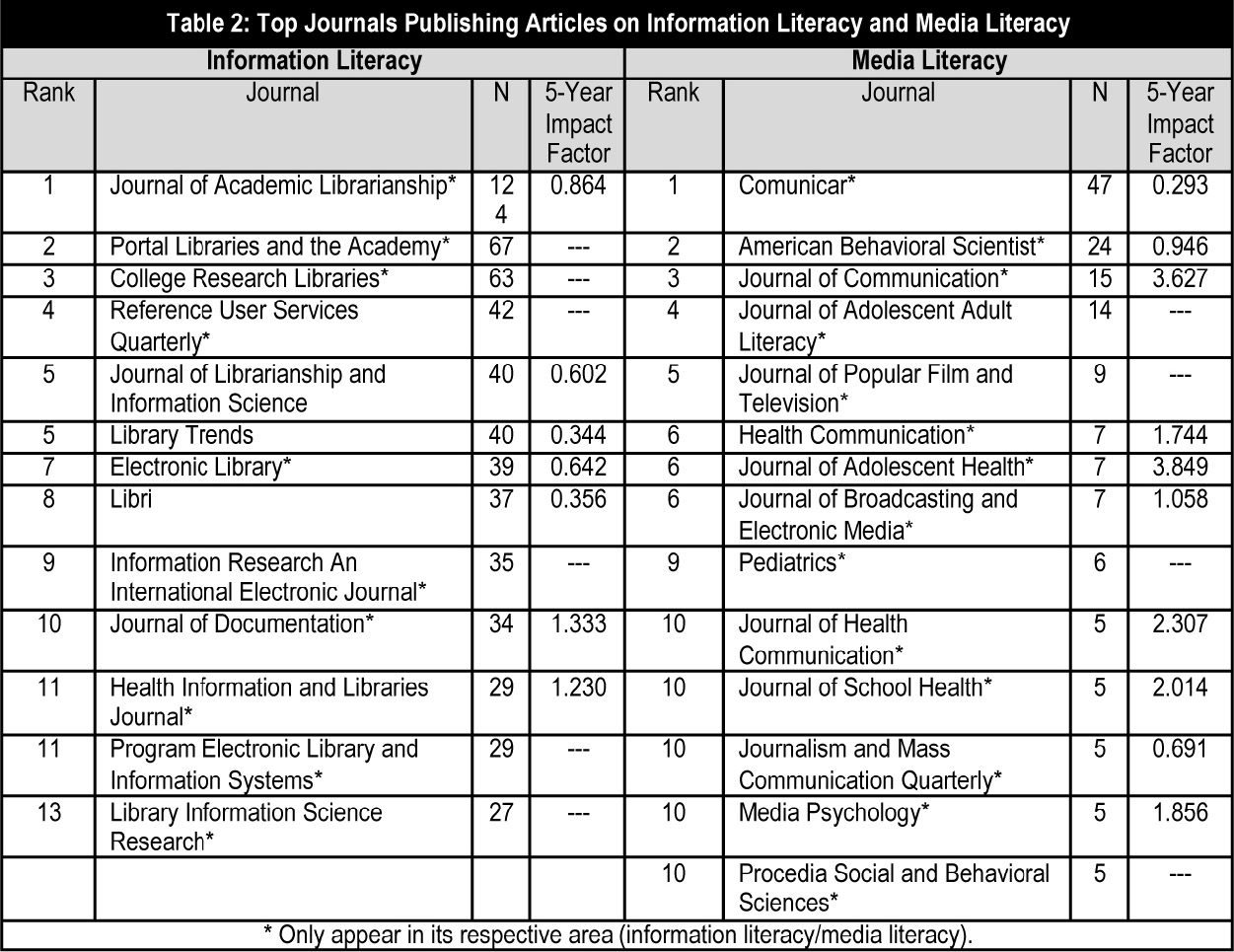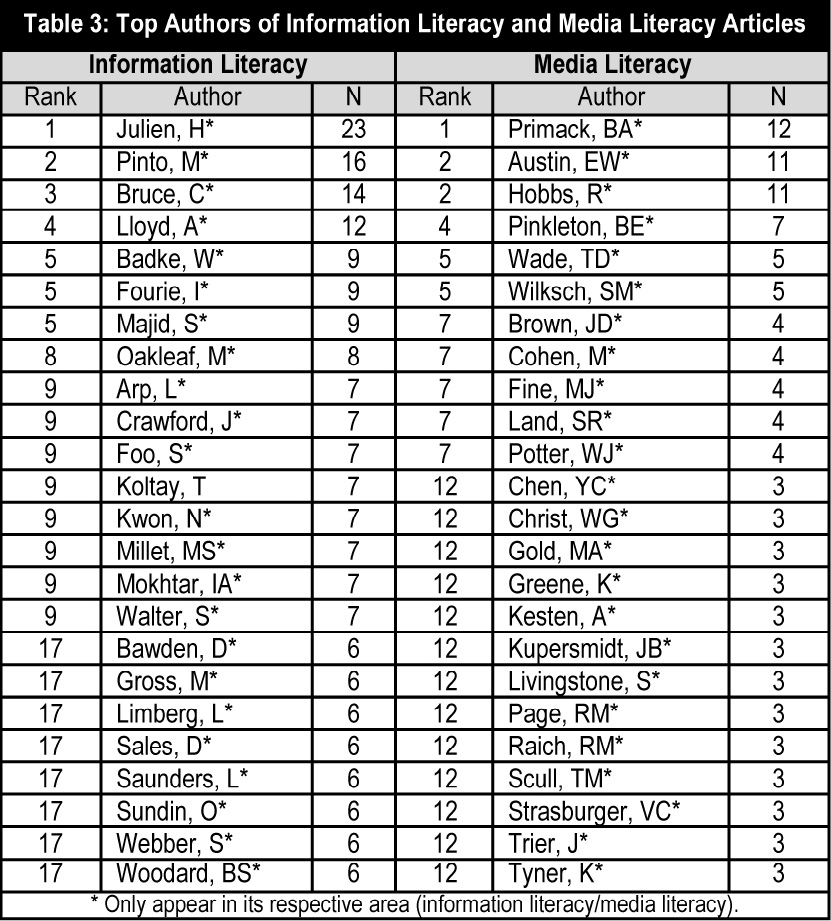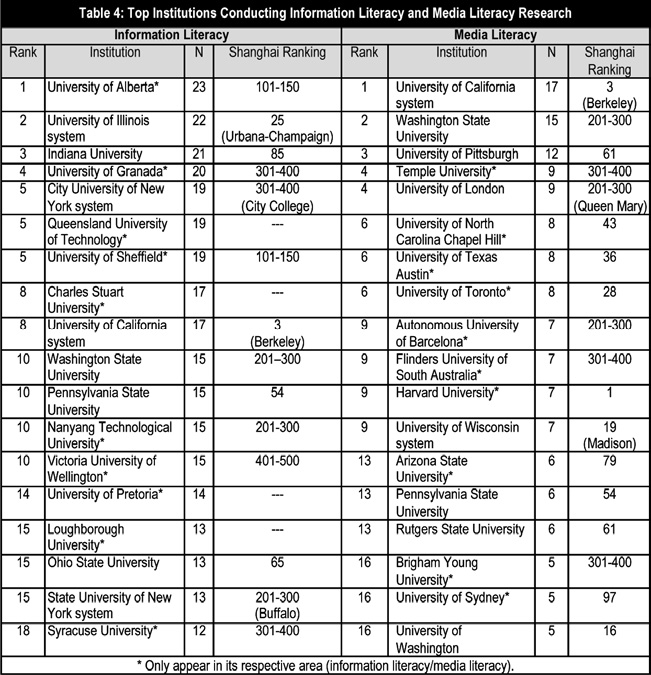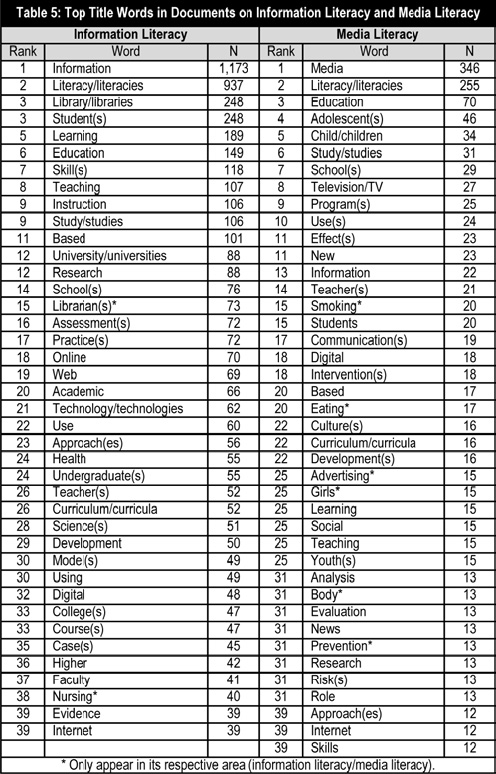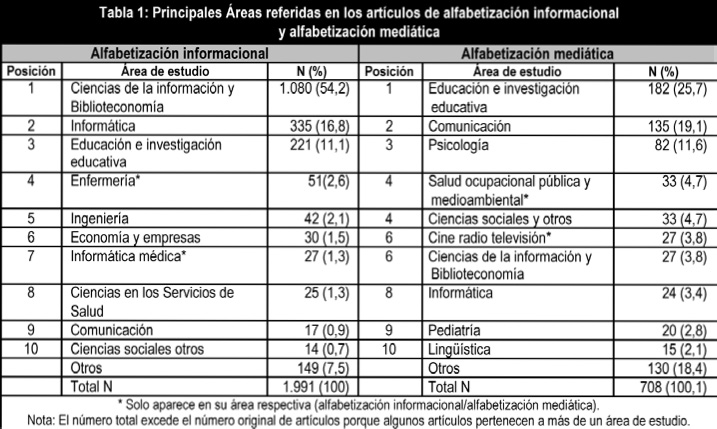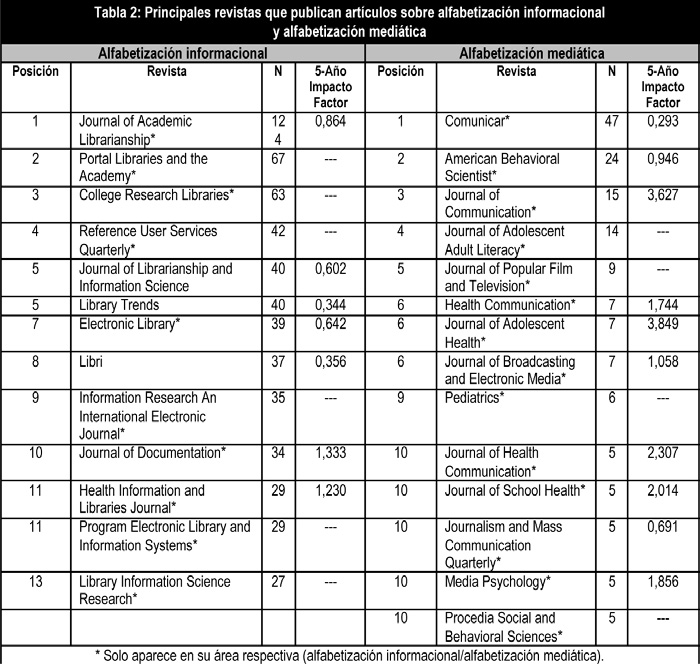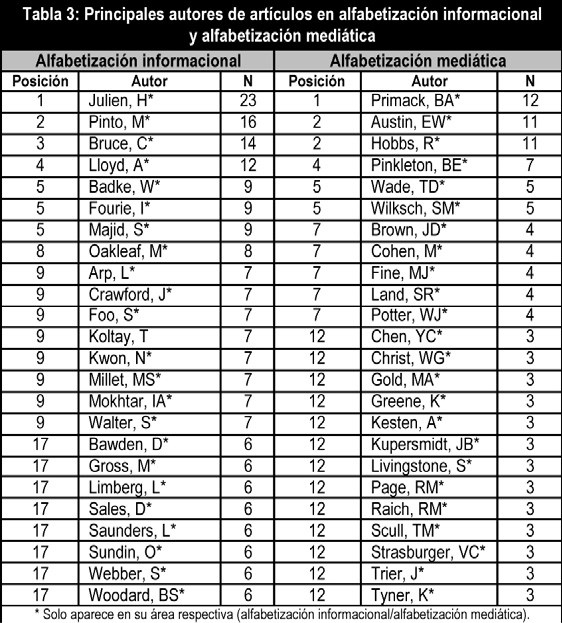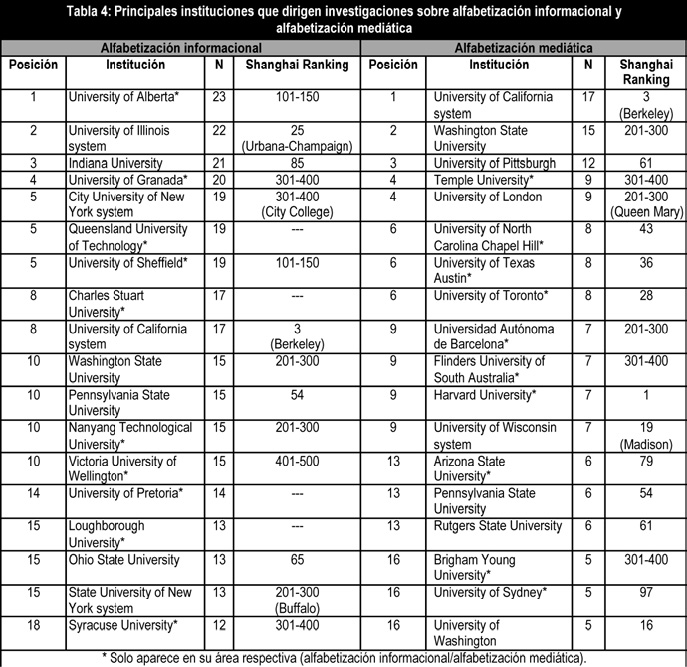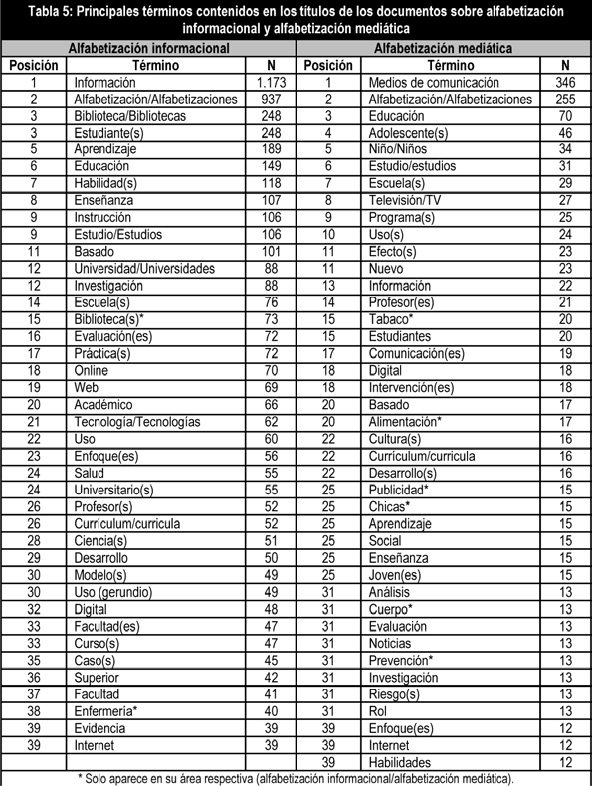Pulsa aquí para ver la versión en Español (ES)
Abstract
In knowledge society, there is currently a call for cultivating a combination of media literacy and information literacy. This, however, requires cooperation from these two separate fields of study, and uncertainty regarding their boundaries hinders a smooth merger. It is unclear whether they are subsets of each other or separate entities. In this study, we have explored the relationship between these two fields by empirically mapping out their territories and discussing their similarities and differences. We have made use of the Web of Science database to delineate the content and boundary of these two fields. Our findings from 1956 to 2012 show that the two fields have different authors, university affiliations, and journals; they also differ in terms of academic origin, scope, and social concern. Information literacy has a closer tie to library science, while media literacy is more related to media content, media industry, and social effects. Due to their different academic orientations, the two fields adopt different analytical approaches. We have found that media literacy is not a subset of information literacy as some scholars have suggested, although the two fields have similarities. They share the same goal, and their publications overlap in terms of subject areas, countries of origin, and titles. The two fields could find common ground by cooperating together to contribute to the promotion of new literacy in knowledge societies.
1. Introduction
The 21st century has so far been a time of rapid change. Many countries are gradually shifting from industrial societies to knowledge societies, and this transition brings with it significant social transformations. In this new era, people need nontraditional competencies and skills to cope with the changing social and technological environments. Led by UNESCO, a new literacy movement to promote media and information literacy (MIL) has been launched. The purpose of the movement is to bring the fields of information literacy and media literacy together as a combined set of competencies necessary for life and work today (UNESCO, 2012). However, an ambiguous understanding of the boundaries and territories of these two fields makes cooperation somewhat challenging. It seems that the professionals in both fields do not have a full understanding of each other and have failed to establish a commonality. As a consequence, they have not been satisfactorily merged (Badke, 2009).
Media literacy has a long history, but its rapid development has only been noted in the past two decades. Over time, it has been framed in different ways (Brown, 1998; Potter, 2010). In Canada, media education is defined as «the process through which individuals become media literate – able to critically understand the nature, techniques and impacts of media messages and productions» (Media Literacy Week, 2010: 1). In the United Kingdom, media literacy is defined by Ofcom (2010: 1) as «the ability to access, understand and create communications in a variety of context». Media literacy is considered to be a series of communication competencies, including the ability to access, analyze, evaluate, and communicate information in a variety of forms (Lee, 2010; NAMLE, 2010). Although these definitions look different, they address similar purposes, including critically engaging with media messages and increasing the ability to access, understand, analyze, use, and create media products.
Different definitions of information literacy have also been proposed. For example, a study group for the National Forum on Information Literacy defines information literacy as the ability to access, evaluate, and use information from a variety of sources; this group has also developed a series of outcome measures. The Information Literary Group at the University of Calgary describes information literacy as «the ability to recognize the need for information and knowing how to access, evaluate, synthesize and communicate it» (Moeller & al., 2011: 32). In UNESCO’s «Towards Information Literacy Indicators», Catts and Lau (2008) conclude that information literacy is the ability of an individual to 1) recognize their information needs; 2) locate and evaluate the quality of information; 3) store and retrieve information; 4) make effective and ethical use of information; 5) apply information to create and communicate knowledge.
Although media literacy and information literacy look like two separate fields, both concepts share the common goal of cultivating people’s ability to access, understand, use, and create media messages or information. In the literacy family, they have always been seen as being closely linked. When the world entered the Internet age, the boundary between them became further blurred by digital technologies. Literacy actually has a symbiotic relationship with communication technology. When computer technology converged with media technology in the 1990s, which was referred to by Koelsch (1995) as the infomedia revolution, there was already a call for expanding the concept of media literacy to encompass infomedia literacy (Lee, 1999). As the Internet further advances, people need to acquire the skills and competencies of multiple literacies (Buckingham, 2007; Westby, 2010). Various concepts, such as multiliteracies (New London Group, 1996) and multimodality (Kress, 2003), have been proposed to address this need.
2. Different views on the relationship between the two fields
The development of digital technology is a key factor for combining media literacy and information literacy. In the Internet age, it is no longer adequate for librarians to offer a static set of indices and search tools. They need to be able to competently use the latest information technologies and to adopt a critical approach in handling information in libraries and beyond (Mitrano & Peterson, 2012). Therefore, information literacy experts are aware of the need to reach out to the media world and to pay more attention to the critical analytical skills of media literacy. On the media literacy side, while facing the vast amount of information in the digital age, these practitioners also recognize the importance of utilizing information literacy skills for searching, evaluating, and organizing information.
Many academics and educators around the world are making efforts to draw media literacy and information literacy together. However, in order to successfully integrate the two concepts, people from the two sides need to understand each other well and know how to complement each other. However, to date, different views of their relationship have hindered substantial cooperation between the two fields. Two contrasting perspectives about their relationship have frequently been mentioned: «On the one hand, information literacy sees media education as a subset of its broader tenets. On the other hand, media literacy conceptualizes information as a subcategory of its broader spectrum of concerns» (Grizzle, 2010; Gutierrez & Tyner, 2012: 34).
In fact, many academics from the library science field regard information literacy as an umbrella concept that encompasses media literacy (Boekhorst, 2012; Kurbanoglu 2012). While Abid (2004) and McClure (1994) point out that media literacy is a major element of information literacy, some others propose that media messages are part of the broader term of information. While conducting a detailed review of the concept of information literacy and media literacy, Bawden (2001: 6) found that many authors in the field of information literacy «prefer to see media literacy as a component of information literacy». Badke (2009: 47) has described three movements (media literacy, information and communication technologies, and information literacy) as moving toward a point of convergence; he states, «I see the information literacy movement as the best contender to draw together the other literacy movement into a single emphasis».
In Ofcom’s adult media literacy report, Livingstone, Couvering and Thumim (2005: 16) state that «media literacy sees media as a lens through which to view the world and express oneself, while information literacy sees information as a tool with which to act on the world» and that «both perspectives are relevant for developing media literacy policy». In the report, information literacy was brought to be discussed under the domain of media literacy. With regard to meeting the challenges of the Internet age, Hobbs (2010: 23) proposes the concept of digital and media literacy and includes «using information search and evaluation strategies» in her proposed curriculum outline. These scholars consider information literacy to be a useful tool of media literacy, and some experts just do not agree that media literacy is a subset of information literacy. To them, although a media message is a kind of information, media literacy does not only deal with media content, but also encompasses a large number of media institutions and the whole communication industry, which are not covered by information literacy.
Apparently, a consensus has not been reached regarding the boundaries and territories of these two fields, although both sides recognize the need for convergence. Badke (2009: 48) warned about «the danger of living in silos», saying that separation is a hurdle that these literacies must overcome so that they can play a foundational role in today’s education. Koltay (2011) also comments that media literacy has to find its essential role in education as one aspect of some kind of multiple or multimodal literacy.
While UNESCO is seeking to promote media and information literacy around the world, a few studies have tried to address the dichotomy between the separate fields of information literacy and media literacy. Lau (2013) argues that both concepts aim at facilitating the development of information skills. The difference between them is in the information objects that they focus on, as one concentrates on mass media messages, while the other focuses on information in general. Carbo (2013: 97-99) proposes the use of «metaliteracy» as a bigger umbrella to bring together the many different competencies needed in the new society. Information literacy is central to this theoretical construct, which includes media and other literacies as components. While these two articles adopt a qualitative approach and information science perspective to discuss the specifications of the two concepts, Gendina (2013: 119) found that in Russia and the Commonwealth of Independent States «information literacy and media education develop in silos, hardly interacting with one another». The boundary dispute between two fields remains unsettled.
The objective of this study is to investigate the relationship between information literacy and media literacy. In sum, there are three competing views: 1) Media literacy and information literacy are basically different; 2) media literacy and information literacy are not the same but do have some overlaps; 3) and media literacy is just a subset of information literacy. Through investigating empirical data, we have sought to determine which of these views is closest to reality.
3. Research method
In the academic world, there are established criteria for evaluating a discipline or a field of study. Heckhausen (1972) distinguishes between disciplines by applying seven different criteria: its set of objectives, subject matter, level of theoretical integration, methods, analytical tools, applications, and historical contingencies. So (1995) has delineated a particular discipline according to its constituting members, institutions, theoretical approaches, stock of knowledge, subject matter, and group identity. A field of study is usually defined by the presence of certain subject matter but not by the existence of certain theoretical elements. By adopting these criteria for evaluating a discipline/field of study, we have compared media literacy and information literacy by empirically examining several aspects, including their patterns of development, academic origins, journals, constituting members, institutions, and subject matter.
In this study, we have made use of the Web of Science database, which includes about 12,000 journals, 150,000 conference proceedings, and more than 47 million documents from 250 fields. It is widely recognized, authoritative, and easily accessible. To be as inclusive as possible, we chose to use all document types from all three indices and from all possible years. The exact date of data collection was February 2, 2013. We searched the database by topic instead of title, as the former is more inclusive and is not limited by specific title words. We looked at the key words of «information literacy» and «media literacy» from 1956 to 2012 to determine what territory each concept would empirically reveal. Specifically, we gathered information about various descriptors, including: 1) the size of the territories; 2) the years in which the documents were published in order to see the trend; 3) the subject areas involved; 4) the journals in which the documents were published; 5) the countries of origin; 6) the authors; 7) the institutions; 8) the words used in the document titles.
The term «information» generated 1,451,947 document items. The term «media» generated 912,069 items. In contrast, «literacy» only produced 25,706 items as it is more specific in focus. For the combination of information and literacy (i.e., the terms were not necessarily adjacent to each other or formed a single concept), there were 4,803 items in the database. Using lemmatization and a more restricted search, the term «information literacy» generated 1,501 items. Similarly, for media and literacy, there were 1,468 items, but for «media literacy», there were only 467 items. From the above numbers, it is clear that the fields related to «information» are larger in scope than those related to «media». The ratio was about 1.6 to 1. Between «information literacy» and «media literacy», the specific ratio of documents found was about 3.2 to 1, which is even larger.
4. The landscapes of information literacy and media literacy
Information literacy is an area that is receiving increasing attention in academia. Before the 1990s, there were very few studies about this topic, and by 1994, it still only accounted for 3.4% of the total documents. Research in this area slowly began to increase, and between 1995 and 2004, the share rose to 22.4%. This interest has continued to grow; from 2005 onwards, the topic of information literacy accounted for 73.8% of the documents in the Web of Science database.
In terms of the subject areas of the information literacy articles, information science and library science are the most popular topics at 54.2% (see Table 1). Two closely related areas are computer science (16.8%) and education and educational research (11.1%). The other topics vary, and each comprises a very small percentage of the overall content area. So it is obvious that this information literacy is unmistakably situated in the areas of information science and library science. Among the top 13 journals shown in Table 2, all of them are in the field of library and information science. The Journal of Academic Librarianship stands out as the most important publication outlet.
Table 3 shows the top 24 authors in the field of information literacy. Heidi Julien, Maria Pinto, and Christine Bruce are the top three authors on the list. Table 4 is a list of the top institutions involved in information literacy research. Researchers from the University of Alberta and the University of Illinois head the list. Among the 18 institutions analyzed, 9 are from the United States and the rest are from 6 other countries. As expected, the United States has produced the lion’s share of the documents in information literacy at 40.6%. England (7.7%) and Australia (6.9%) take the second and third spots, respectively, followed by Canada (5.3%) and China (4.7%). Among the 17 countries and territories currently researching information literacy, most of them are in North America, Europe, and East Asia.
The use of certain words in the document titles can reveal the research foci in information literacy studies. When counting the words that appeared in all the documents, we found that «information» (N= 1,173) and «literacy/literacies» (N=937) were the top two words. The rest of the frequently used words help to illuminate the focus of information literacy research. Table 5 shows that there are three groups of words. The first group is related to library science (e.g., library and librarian). The second group is related to education (student, learning, education, instruction, teaching, university, etc.). The third group is related to technology (online, web, technology, digital, and Internet). It is worth noting that the word «media» is not on this list.
The concept of media literacy began to be addressed in the documents in the Web of Science database beginning in 1995, and this focus has grown steadily ever since. Before 1995, its share of the database was only 3%, but this percentage jumped to 26.2% between 1995 and 2004. Interest in media literacy has continued to rapidly develop in the past few years. From 2005 and onwards, it has accounted for 70.9% of the total documents.
There is no single dominant area in media literacy. The top three research areas are education and educational research (25.7%), communication (19.1%), and psychology (11.6%). The other fields, as shown in Table 1, include other social sciences, health and information, and library science. Table 2 shows the various journals that publish media literacy articles. Comunicar is the top journal (N = 47), followed by American Behavioral Scientist (N=24). For the rest of the journals, there are two major areas of focus—communication and health. There are also some «hybrid» journals involving both of these fields, such as Health Communication and the Journal of Health Communication.
The major authors in media literacy are Brian Primack, Renee Hobbs, and Erica Austin. In terms of the institutions most related to media literacy, the University of California system tops the list, while Washington State University is a close second. As Table 4 also shows, among the 19 institutions, the United States is home to 14 of them. The other countries represented include Australia, England, Canada, and Spain. For the origins of the documents, the United States ranks first with a share of 51.8%. England comes second, but its share is only 5.8%. Canada, Spain, and Australia are also near the top of the list. North American and European countries are dominant, but East Asian countries, such as China, Japan, and South Korea, are becoming a rising force.
The title words related to media literacy are shown in Table 5. The words «media» and «literacy» rank first and second, with 346 and 255 uses, respectively. Three groups of words were identified: The first group had something to do with education (such as education, school, teacher, student, or curriculum), the second group of words was related to communication (such as television, effect, communication, advertising, news, or Internet), and the third group was health related (such as smoking, eating, prevention, intervention, or risk). Here we also see the presence of the word «information».
5. Similarities and differences
We can compare the two fields in terms of six aspects. The first aspect is their similar patterns of development. The two concepts have developed rather quickly in recent years. This acceleration is most obvious in the 2000s, especially from the year 2005 onwards. In the past two decades, the two fields have been young and upcoming academic areas in the literacy family (Google, 2012). As for affiliated countries, the United States is the most important place for both information literacy and media literacy research. Other countries that are active in both areas include England, Australia, Canada, Spain, China, and South Africa.
The second aspect is their different academic roots. While information literacy emerged from the library and information sciences, media literacy originated from the media, education, and social sciences. The top three journals that carry information literacy publications are library journals, while those carrying media literacy publications are communication and social sciences journals. Media literacy-related journals tend to have higher impact factors, while the library journals are either non-Social Sciences Citation Index publications or have lower impact factors (table 2).
The third aspect is the difference of constituting members and institutions. In Table 3, of the 48 authors shown on both lists, only one of them is listed in both fields. For the top three authors on each list, they do not appear at all on the other list. This level of divergence is a good indicator that the two fields are being investigated by two entirely different groups of researchers. The institutional affiliations in Table 4 essentially repeat this finding. Of the 37 universities listed on both lists, most of them do not overlap. Of the 18 media literacy-related universities, 12 are ranked among the top 100 in the 2013 Shanghai Ranking of world universities. Of the 18 information literacy-related universities, the corresponding number is only 5.
The fourth aspect is their overlapping scopes and subject matters. Education is the common bond between the two fields (Table 5). This overlap forms a basis for the proposed integration and cooperation, but each field also has its own emphasis, as can be seen in their major title words. In fact, they also differ in terms of their targets of study. The objects of interest for the information literacy scholars are mainly peer-reviewed publications. For media literacy, the attention is focused on mass media and media messages. In recent years, they have both focused on multimedia material and have been associated heavily with information and communication technologies. There is also an overlap between the two fields in terms of subject area. Both literacy concepts guide users to meet their information needs through locating, retrieving, evaluating, using, and communicating media and information. One is more concerned with research skills, while the other is linked with critical analysis of media products (Hobbs, 2010; Lau, 2013).
The fifth aspect is their divergent analytical approaches. Information literacy concentrates on analyzing information (Lau, 2013). Therefore, it mainly focuses on textual analysis and emphasizes the research value of finding the truth in documents. It is concerned with the critical assessment of research-related information quality but it does not examine information audience and information effects (Lau, 2013). In contrast, media literacy has strong academic roots in media studies and social sciences. It addresses key facets of the mass media phenomena, such as media messages, media industries, media audiences, and media effects (Martens, 2010). Thus, media literacy adopts more analytical approaches. Apart from textual analysis, it also conducts institutional analysis, medium analysis, and audience analysis.
The sixth aspect is their objectives. Information literacy and media literacy have the same objective – training people to access, understand, evaluate, communicate, use, and create media messages and information. Both highlight the importance of the ethical use of information, the critical analysis of content, the use of multimedia platforms, and knowledge production. There is a recent call for information literacy to extend its functions to build citizenship, to guarantee the survival of democratic institutions, to serve as a vital tool for lifelong learning, and to address the value of relevant information in a commercial world that is driven by a knowledge economy (Bawden, 2001). Media literacy scholars also propose that media literacy should contribute to democracy, the knowledge economy, and lifelong learning (Livingstone & al., 2005).
6. Discussion and conclusion
The empirical findings from the Web of Science database show that there are more differences than similarities between the fields of information literacy and media literacy. Information literacy is a much larger field than media literacy. It has a clear but narrow focus on library science and technology. On the other hand, media literacy has a broader scope and is more related to communication, health-related issues, leisure, effects, and culture. It is clear that these fields overlap to some extent, but media literacy is not a subset of information literacy, and information literacy is also not a subcategory of media literacy.
These two fields come from different academic traditions, have different concerns, and play different roles in the process of educating people and raising literacy levels. Information literacy is more related to information storage, processing, and use, while media literacy is concerned more with media content, media industry, and social effects. Despite their differences, however, they have a number of common concerns. Information literacy and media literacy share common goals and future directions. They overlap in the core skills they aim to develop. They both aim at cultivating literate individuals who can make informed judgments regarding the use of information in the digital age. Both emphasize the use of multimedia platforms and knowledge creation. While we recognize their differences, it is not difficult to find that the two fields are, in fact, linked and complementary.
The experts in these two fields should seek to learn from each other and to understand the specifics of the other field. In today’s world, neither information literacy nor media literacy alone is sufficient to equip individuals to deal with the huge volume of media messages and the abundance of information platforms. There is an urgent call to combine these two fields to develop a joint set of media and information literacy competencies needed in the new technological environment. Their integration could certainly facilitate individuals’ participation in the emerging knowledge societies.
References
Abid, A. (2004). Information Literacy for Lifelong Learning. Paris: UNESCO.
Badke, W. (2009). Media, ICT, and Information Literacy. Online, 33(5), 47-49.
Bawden, D. (2001). Information and Digital Literacies: A Review of Concepts. Journal of Documentation, 57(2), 218-259.
Boekhorst, A.K. (2012). (M)IL and its Kind. Paper presented at the International Conference of the Media and Information Literacy for Knowledge Society. June 24-28, 2012, Moscow, Russia.
Brown, J.A. (1998). Media Literacy Perspectives. Journal of Communication, 48(1), 44-57.
Buckingham, D. (2007). Digital Media Literacies: Rethinking Media Education in the Age of the Internet. Research in Comparative and International Education, 2(1), 43-55.
Carbo, T. (2013). Conceptual Relationship of Information Literacy and Media Literacy: Consideration within the Broader Mediacy and Metaliteracy Framework. In Conceptual Relationship of Information Literacy and Media Literacy (pp. 92-101). Paris: UNESCO.
Catts, R. & Lau, J. (2008). Towards Information Literacy Indicators. Paris: UNESCO. (http://unesdoc.unesco.org/images/0015/001587/158723e.pdf) (01-07-2013).
Gendina, N. (2013). Media and Information Literacy in Russia and the Countries of the Commonwealth of Independent States (CIS). In Conceptual Relationship of Information Literacy and Media Literacy (pp. 102-128). Paris: UNESCO.
Google (2012). Google Ngram Viewer. Retrieved from http://books.google.com/ngrams/-graph?content=information+literacy%2Cmedia+literacy&year_start=1800&year_end=2012&corpus=15&smoothing=2&share=.
Grizzle, A. (2010). Media & Information Literacy: The UNESCO Perspective. Journal of Media Literacy, 57(1&2), 34-36.
Gutierrez, A. & Tyner, K. (2012). Media Education, Media Literacy and Digital Competence. Comunicar, 19 (38), 31-39. (http://search.proquest.com/docview/1112903180?accountid=10371).
Heckhausen, H. (1972). Discipline and Interdisciplinarity. In Centre for Educational Research and Innovation (Ed.), Interdisciplinarity: Problem of Teaching and Research in Universities (pp. 83-89). Paris: Organization for Economic Co-operation and Development (OECD) Publications.
Hobbs, R. (2010). Digital and Media Literacy: A Plan of Action. Washington, DC: The Aspen Institute.
Koelsch, F. (1995). The Infomedia Revolution: How it is Changing our World and our Life. Toronto: McGraw-Hill Ryerson.
Koltay, T. (2011). The Media and the Literacies: Media Literacy, Information Literacy, Digital Literacy. Media, Culture & Society, 33(2), 211-221. (DOI: 10.1177/0163443710393382).
Kress, G. (2003). Literacy and Schooling: A Sociocognitive Perspective. In E. Hiebert (Ed.), Literacy for a Diverse Society (pp. 9-27). New York: Teachers College Press.
Kurbanoglu, S. (2012). An Analysis of Concept of Information Literacy. The International Conference of the Media and Information Literacy for Knowledge Society. June 24-28, 2012, Moscow, Russia.
Lau, J. (2013). Conceptual Relationship of Information Literacy and Media Literacy. In Conceptual Relationship of Information Literacy and Media Literacy (pp. 76-91). Paris: UNESCO.
Lee, A.Y.L. (1999). Infomedia Literacy: An Educational Basic for the Young People in the New Information Age. Information, Communication and Society, 2(2), 134-155.
Lee, A.Y.L. (2010). Media Education: Definitions, Approaches and Development around the Globe. New Horizons in Education, 58 (3), 1-13.
Livingstone, S., Van Couvering, E.J. & Thumim, N. (2005). Adult Media Literacy: A Review of the literature. London: Ofcom.
McClure, L.J. (1994). Network Literacy: A Role for Libraries, Information Technology and Libraries, 13, 115-125.
Media Literacy Week (2010, November). What is Media Education? (www.medialiteracyweek.ca/en/101_whatis.htm).
Mitrano, T. & Peterson, K. (2012). Information Literacy for the Academic Librarian in the Digital Information Age: Supporting Users to Make Effective Use of the Collection. In M. Fieldhouse & A. Marshall (Eds.), Collection Development in the Digital Age (pp. 181-196). London: Facet Publishing.
Moeller, S., Joseph, A., Lau, J. & Carbo, T. (2011). Towards Media and Information Literacy indicators: Background Document of the Expert meeting 4-6 November 2010, Bangkok, Thailand. Paris: UNESCO.
NAMLE (2010). Media Literacy Defined. National Association for Media Literacy Education. (http://namle.net/publications/media-literacy-definitions).
New London Group (1996). A Pedagogy of Multiliteracies: Designing Social Futures. Harvard Educational Review, 66(1), 60-93.
Ofcom (2010). What is Media Literacy – Ofcom’s Definition. (http://stakeholders.ofcom.org.uk/market-data-research/media-literacy/about).
Potter, W. J. (2010). The State of Media Literacy. Journal of Broadcasting & Electronic Media, 54(4), 675-696. (DOI:10.1080/08838151.2011.521462).
So, C.Y.K. (1995). Mapping the Intellectual Landscape of Communication Studies: An Evaluation of its Disciplinary Status. Unpublished Ph.D. dissertation. Philadelphia: University of Pennsylvania.
UNESCO (2012). Media and Information Literacy. Communication and information. (www.unesco.org/new/en/communication-and-information/media-development/media-literacy/mil-as-composite-concept).
Westby, C. (2010). Multiliteracies: The Changing World of Communication. Top Lang Disorders, 30(1), 64-71.
Click to see the English version (EN)
Resumen
En la sociedad del conocimiento presenciamos la necesidad de plantear una combinación de alfabetización mediática e informativa que requiere, sin embargo, cooperación entre estas dos áreas de estudio independientes. La incertidumbre que rodea estos vínculos dificulta una fusión homogénea, y no resulta fácil determinar si, cuando hablamos de estas alfabetizaciones, nos referimos a subcategorías o entidades independientes. En este estudio hemos explorado la relación existente entre estas dos áreas de estudio determinando empíricamente sus territorios atendiendo a sus similitudes y diferencias. Para ello, hemos empleado la base de datos bibliográfica Web of Science, con el objetivo de delinear el contenido y los nexos comunes a ambos campos. Los hallazgos realizados entre 1956 y 2012 muestran cómo en cada ámbito se desarrollan distintos autores, afiliaciones universitarias y revistas; asimismo, también difieren en términos de origen académico, alcance e interés social. Mientras que la alfabetización informacional tiene una relación más estrecha con la biblioteconomía, la alfabetización mediática está más conectada con el contenido mediático, la industria de los medios y los efectos sociales que éstos causan. Debido a estas diferencias de orientación académica, ambos campos adoptan enfoques analíticos diferentes. En contra de lo sugerido por algunos expertos, hemos podido determinar que la alfabetización mediática no es una simple categoría de la alfabetización informacional, a pesar de que ambos campos muestran similitudes: comparten el mismo objetivo, y sus publicaciones se sola-pan en áreas temáticas, países de origen y títulos. Ambas disciplinas podrían identificar contextos comunes cooperando conjuntamente para contribuir a la promoción de nuevas alfabetizaciones en las sociedades del conocimiento.
1. Introducción
El siglo XXI ha sido sin duda una época de cambios acelerados. Muchos países han presenciado la transformación de sus sociedades industriales en sociedades del conocimiento, y esta transición lleva consigo transformaciones sociales significativas. En esta nueva era, la sociedad precisa de competencias y destrezas renovadas para adaptarse a los nuevos medios de cambio social y tecnológico. De la mano de la UNESCO ha surgido un movimiento de alfabetización para promover la alfabetización mediática e informacional (MIL), con el objetivo de unir ambas en un conjunto combinado de competencias necesarias para la vida y el ámbito profesional en la actualidad (UNESCO, 2012). No obstante, el entendimiento ambiguo de los límites y territorios de ambos campos hace que esta cooperación se convierta en un desafío. Parece ser que los profesionales de ambos campos no poseen un conocimiento exhaustivo mutuo y por ello no se ha logrado establecer un nexo común. Como consecuencia, no han conseguido fusionarse satisfactoriamente (Badke, 2009).
La alfabetización mediática tiene una larga historia, pero no hemos sido conscientes de su gran desarrollo hasta las dos últimas décadas. Con el paso del tiempo, la alfabetización mediática se ha visto enmarcada y definida de múltiples formas (Brown, 1998; Potter, 2010). En Canadá, la educación mediática se entiende como «el proceso mediante el cual los individuos se vuelven competentes mediáticamente, es decir, capaces de entender de forma crítica la naturaleza, técnicas e impactos de los mensajes y producciones de los medios» (Media Literacy Week, 2010: 1). En el Reino Unido el término aparece definido por Ofcom (2010: 1) como la «habilidad de acceder, comprender y crear comunicación en una variedad de contextos». La alfabetización mediática se considera como una serie de competencias comunicativas, incluyendo la habilidad de acceder, analizar, evaluar y transmitir comunicación de formas diferentes (Lee, 2010; NAMLE, 2010). A pesar de que estas definiciones puedan parecer diferentes, comparten objetivos similares, que pasan por el compromiso crítico con los mensajes mediáticos y con la mejora en la capacidad de acceso, entendimiento, análisis, uso y creación de productos mediáticos.
También se han sugerido distintas definiciones de alfabetización informacional. Por ejemplo, según el grupo de estudio del Forum Nacional de Alfabetización Informacional, ésta se entiende como la habilidad de acceso, evaluación y uso de la información a partir de distintas fuentes. Cabe decir que este grupo ha desarrollado también una serie de medidores de resultados. El Grupo de Alfabetización Informacional en la Universidad de Calgary describe la alfabetización informacional como la «habilidad de reconocer la necesidad de información sabiendo cómo acceder a ella, evaluarla, sintetizarla y comunicarla» (Moeller & al., 2011: 32). Catts y Lau (2008) en «Hacia unos indicadores para la alfabetización informacional» de la UNESCO, concluyen que la alfabetización informacional es la habilidad de un individuo para 1) reconocer sus necesidades informativas; 2) localizar y evaluar la calidad de la información; 3) almacenar y recuperar información; 4) hacer un uso efectivo y ético de la información; 5) aplicar la información a la creación y transmisión de conocimiento.
A pesar de que la alfabetización mediática e informativa parecen ser dos campos independientes, ambos conceptos comparten el objetivo común de cultivar la habilidad de los individuos para acceder, comprender, utilizar y crear mensajes mediáticos o informativos y en el área de la alfabetización siempre han aparecido estrechamente relacionadas. Cuando comenzamos a vivir la era de Internet, los límites entre una y otra se volvieron más difusos debido a las tecnologías digitales. La alfabetización tiene hoy en día una relación simbiótica con las tecnologías de la comunicación. Cuando la tecnología informática convergió con la tecnología mediática en los años noventa –aquello que Koelsch (1995) dio a conocer como la revolución infomediática–, se produjo una llamada a la expansión del concepto de alfabetización mediática para comprender la alfabetización infomediática (Lee, 1999). Debido al continuo avance de Internet, es necesario adquirir nuevas habilidades y competencias de múltiples alfabetizaciones (Buckingham, 2007; Westby, 2010). Varios conceptos, como el de multialfabetización (New London Group, 1996) y el de multimodalidad (Kress, 2003), han sido propuestos para suplir esta necesidad.
2. Diferentes visiones de la relación entre los dos campos
El desarrollo de la tecnología digital es un factor clave para poder combinar ambas alfabetizaciones. En la era de Internet, a los bibliotecarios no les basta con ofrecer conjuntos estáticos de índices y herramientas de búsqueda, puesto que necesitan ser capaces de utilizar de forma competitiva los últimos avances en el campo de las tecnologías de la información y adoptar un enfoque crítico al manejar la información en bibliotecas y demás (Mitrano & Peterson, 2012). Por tanto, los expertos en alfabetización informacional son conscientes de la necesidad de alcanzar el mundo de los medios y prestar más atención a las habilidades analítico críticas de la alfabetización mediática. Del lado de la alfabetización mediática, al tiempo que hacemos frente a la enorme cantidad de información propia de la era digital, se reconoce la importancia de habilidades propias de la alfabetización informacional para buscar, evaluar y organizar la información.
Muchos académicos y educadores de todas partes del mundo se esfuerzan por unir ambas alfabetizaciones, pero para lograr integrar ambos conceptos, es preciso comprender bien cada uno de ellos y saber de qué forma se complementan. Sin embargo, hasta la fecha, las distintas visiones de esta conexión han dificultado la cooperación necesaria entre ambos campos. A menudo se han mencionado dos perspectivas opuestas: «Por un lado, la alfabetización informacional percibe la educación mediática como una subcategoría de su propia disciplina. Por otro, la alfabetización mediática conceptualiza la información como una subcategoría dentro de su gran espectro de preocupaciones» (Grizzle, 2010; Gutierrez & Tyner, 2012: 34).
De hecho, muchos académicos del área de la biblioteconomía conciben la alfabetización informacional como un concepto que abarca la alfabetización mediática (Boekhorst, 2012; Kurbanoglu, 2012). Mientras Abid (2004) y McClure (1994) señalan que la alfabetización mediática es un elemento importante en la alfabetización informacional, otros proponen que los mensajes mediáticos son parte de un concepto más amplio de información. Mientras realizaba una revisión detallada del concepto de alfabetización mediática e informativa, Bawden (2001: 6) descubrió que muchos autores del campo de la alfabetización informacional «prefieren concebir la alfabetización mediática como un componente de la alfabetización informacional». Badke (2009: 47) describe tres movimientos (alfabetización mediática, tecnología de la información y la comunicación y alfabetización informacional) en proceso hacia un punto de convergencia. Según señala, ve el movimiento de la alfabetización informacional como «el mejor candidato para unir el resto de movimientos de alfabetización en un énfasis único».
En el informe Ofcom sobre alfabetización mediática en adultos, Livingstone, Couvering y Thumim (2005: 16) afirman que «la alfabetización mediática concibe los medios de comunicación como una lente a través de la cual ver el mundo y expresarse uno mismo, mientras que la alfabetización informacional concibe la información como una herramienta con la cual actuar en el mundo» y «ambas perspectivas son importantes para el desarrollo de políticas de alfabetización mediática». En el informe se presenta el debate ciñendo la alfabetización informacional al dominio de la alfabetización mediática. Con respecto a los objetivos fijados para la era Internet, Hobbs (2010: 23) propone el concepto de alfabetización digital y mediática, e incluye «el uso de estrategias de búsqueda de información y evaluación» en el diseño curricular propuesto. Estos académicos consideran la alfabetización informacional como una herramienta útil de la alfabetización mediática, y muchos otros expertos no están de acuerdo con que la alfabetización mediática sea una subcategoría de la alfabetización informacional, puesto que aunque para ellos un mensaje mediático es un tipo de información, la alfabetización mediática no solo trata el contenido mediático, sino que también engloba instituciones mediáticas y a la industria de la comunicación en sí, aspectos que no contempla la alfabetización informacional.
Según parece, no se ha alcanzado un consenso en torno a los límites y territorios de estos campos, aunque ambas partes reconocen la necesidad de convergencia. Badke (2009: 48) advirtió del «peligro de vivir en silos aislados», alegando que la separación es un obstáculo que ambas alfabetizaciones deben sobrepasar para poder sentar las bases y fundamentos necesarios en el plano educativo actual. Koltay (2011) afirma igualmente que la alfabetización mediática debe encontrar su papel esencial en la educación como aspecto de algún tipo de alfabetización múltiple o multimodal.
Al tiempo que la UNESCO busca promover ambas alfabetizaciones por el mundo, han aparecido varios estudios que intentan focalizar en la dicotomía existente entre ambas alfabetizaciones. Lau (2013) argumenta que ambos conceptos tienen el objetivo de facilitar el desarrollo de las destrezas informativas. La diferencia entre ellas está en los objetivos informativos en los que se centran: una se concentra en los mensajes de los medios de comunicación, y la otra se concentra en la información en general. Carbo (2013: 97-99) propone el uso de la «metalfabetización» como soporte para unir todas las competencias que necesitamos en las nuevas sociedades. La alfabetización informacional es necesaria para este constructo teórico, que incluye a los medios y otras alfabetizaciones como componentes. Si bien estos dos artículos adoptan un enfoque cualitativo y la perspectiva de la ciencia de la información para debatir sobre la especificidad de ambos conceptos, Gendina (2013: 119) sugiere que en Rusia y en la Comunidad de Estados Independientes (CEI) «la alfabetización informacional y la educación mediática se desarrollan de forma aislada, interactuando rara vez una con otra». El debate sobre los límites entre ambos campos queda por tanto pendiente de resolución.
El objetivo de este estudio es investigar la relación entre alfabetización informacional y mediática. A modo de resumen, existen tres perspectivas contrapuestas: 1) La alfabetización mediática e informativa son básicamente distintas; 2) ambas alfabetizaciones difieran una de la otra pero coinciden en algunos puntos; 3) la alfabetización mediática es una subcategoría de la alfabetización informacional. A partir de datos empíricos, hemos intentado determinar cuál de estas perspectivas está más próxima a la realidad.
3. Método de investigación
En el mundo académico contamos con criterios establecidos para evaluar una disciplina o campo de estudio. Según Heckhausen (1972), distinguimos entre disciplinas mediante la aplicación de siete criterios diferentes según su conjunto de objetivos, temas que tratan, nivel de integración teórica, métodos, herramientas analíticas, aplicaciones y contingencias históricas. So (1995) define disciplina según los miembros constituyentes que se le asocian, instituciones, enfoques teóricos, conocimiento almacenado, objeto de estudio e identidad grupal. Un campo de estudio queda definido a menudo por la presencia de cierto objeto de estudio, pero no por la existencia de elementos teóricos. A partir de estos criterios de evaluación de disciplinas/campos de estudio, hemos comparado la alfabetización mediática e informacional examinando empíricamente varios aspectos, incluyendo los patrones de desarrollo, orígenes académicos, revistas, miembros que la constituyen, instituciones y temas que tratan.
Para este estudio hemos utilizado la base de datos Web Science, que incluye aproximadamente 12.000 revistas, 150.000 actas de congresos y más de 47 millones de documentos de 250 campos y es además bastante conocida, de prestigio y de fácil acceso. Con el fin de recabar un máximo de datos, decidimos utilizar todo tipo de documentos pertenecientes a los tres índices correspondientes y sin restricción de año. La fecha exacta de recopilación de datos data del 2 de febrero de 2013. Emprendimos la búsqueda por tema en lugar de por título para ser más inclusivos y no limitarnos a posibles palabras específicas de los títulos. Atendimos a las palabras clave «alfabetización informacional» y «alfabetización mediática» desde 1956 a 2012 para determinar el territorio que cada concepto revelaría empíricamente. De forma específica, reunimos información sobre varios descriptores, incluyendo: 1) la dimensión del territorio; 2) los años de publicación de los documentos para comprobar así la tendencia; 3) áreas de estudio implicadas; 4) revistas en que se publicaron los documentos; 5) países de origen; 6) autores; 7) instituciones; 8) palabras empleadas en los títulos.
El término «información» generó 1.451.947 ítems, y el término «medios de comunicación» 912.069. En cambio, «alfabetización» solo produjo 25.706 ítems por ser más específico su alcance. Al combinar información y alfabetización (como ejemplo, los términos no eran necesariamente adyacentes uno a otro o formaban un único concepto), aparecieron 4.803 ítems en la base de datos. Usando la lematización y una búsqueda más restringida, el término «alfabetización informacional» generó 1.501 ítems. De forma similar, para medios y alfabetización, aparecieron 1.468 ítems, pero para «alfabetización mediática» solo hubo 467 ítems. De estas cifras se deduce que los campos relacionados con la «información» tienen un ámbito mayor que aquellos relacionados con «medios de comunicación». El índice es de 1,6 a 1. Entre «alfabetización informacional» y «alfabetización mediática», el ratio específico de documentos fue de 3,2 a 1.
4. El panorama de la alfabetización informacional y mediática
La alfabetización informacional es un área que recibe cada vez más atención por parte de la academia. Antes de los 90 había muy pocos estudios sobre el tema, y en 1994 sigue suponiendo tan solo el 3,4% del total de documentos. La investigación en esta área comenzó a aumentar entre 1995 y 2004, ascendiendo a un porcentaje de 22,4%. El interés ha continuado creciendo y de 2005 en adelante, el tema supone ya el 73,8% de los documentos en la base de datos consultada.
En lo que respecta a las áreas de estudio de los artículos sobre alfabetización informacional, los temas más populares son las ciencias de la información y la biblioteconomía, con un 54,2% (tabla 1). Otras dos áreas que las siguen de cerca son la informática (16,8%) y la educación e investigación educativa (11,1%). El resto de temas varían y cada uno comprende un porcentaje menor del contenido total del área. Por tanto, parece evidente que la alfabetización informacional se sitúa indiscutiblemente en el área de las ciencias de la información y la biblioteconomía. Las 13 principales revistas de investigación que se muestran en la tabla 2 pertenecen a estas áreas, y la Revista Journal of Academic Librarianship se perfila como la publicación más destacada.
La tabla 3 muestra los 24 autores principales en el campo de la alfabetización informacional. Heidi Julien, Maria Pinto, y Christine Bruce son los tres autores principales de la lista. La tabla 4 es una lista de las principales instituciones implicadas en la investigación en alfabetización informacional. La lista la encabezan los investigadores de la Universidad de Alberta y de la Universidad de Illinois. De las 18 instituciones analizadas, nueve son estadounidenses y el resto pertenecen a otros seis países. Como se preveía, Estados Unidos encabeza la lista de documentos sobre alfabetización informacional con un 40,6%. Inglaterra (7,7%) y Australia (6,9%) ostentan la segunda y tercera posición, respectivamente, seguidas de Canadá (5,3%) y China (4,7%). Entre los 17 países y territorios que investigan actualmente en el campo de la alfabetización informacional, la mayoría se localizan en Norteamérica, Europa y el este de Asia.
El uso de algunos términos en el título de los documentos puede revelar los distintos enfoques en estudios de alfabetización. Al contar los términos que aparecen en los documentos, hallamos que «información» (N= 1.173) y «alfabetización/alfabetizaciones» (N=937) son las dos más recurrentes. El resto de palabras frecuentes ayudan a desvelar el objetivo de las investigaciones en alfabetización informacional. La tabla 5 muestra tres grupos de palabras. El primero está relacionado con la biblioteconomía (por ejemplo, biblioteca y bibliotecario). El segundo grupo está relacionado con la educación (estudiante, aprendizaje, educación, instrucción, enseñanza, universidad, etc.). El tercer grupo está relacionado con la tecnología (on-line, web, tecnología, digital e Internet). Es preciso señalar que el referente «medios de comunicación» no aparece en esta lista.
El concepto de alfabetización mediática comenzó a aparecer en documentos de la base de datos consultada (Web Science) a principios de 1995, y su atención se ha mantenido creciendo de forma constante desde entonces. Previamente a su origen, solo suponía un 3% del total en dicha base de datos, pero este porcentaje ha aumentado hasta un 26,2% entre 1995 y 2004. El interés en la alfabetización mediática ha continuado desarrollándose en los últimos años y, después de 2005, ha logrado alcanzar el 70,9% del total de documentos.
No existe una única área que domine el panorama de la alfabetización mediática. Las tres principales áreas son educación e investigación educativa (25,7%), comunicación (19,1%) y psicología (11,6%). El resto de campos, como se aprecia en la tabla 1, incluyen otras áreas sociales, salud e información y biblioteconomía. La tabla 2 muestra las distintas revistas de investigación que publican artículos sobre el tema. «Comunicar» es la principal revista de investigación (N=47), seguida por «American Behavioral Scientist» (N=24). El resto de revistas se centran en otras dos áreas principales: comunicación y salud. También localizamos algunas revistas de naturaleza «híbrida» que incluyen ambos campos, como son «Health Communication» y «Journal of Health Communication».
Los principales autores en esta área son Brian Primack, Renee Hobbs y Erica Austin. En el campo de las instituciones, la University of California System encabeza la lista, seguida de cerca por Washington State University. Como muestra la tabla 4, Estados Unidos acoge 14 de un total 19 instituciones. El resto de países representados son Australia, Inglaterra, Canadá y España. En cuanto al origen de los documentos publicados, Estados Unidos encabeza la lista con un 51,8%, seguido de Inglaterra, con tan solo un 5,8%. Canadá, España y Australia también están cerca de las primeras posiciones. Norteamérica y Europa dominan el panorama, pero algunos países del este de Asia, como China, Japón y Corea del Sur están posicionándose como fuerzas emergentes.
En la tabla 5 aparecen los términos más recurrentes en relación con la alfabetización mediática. Los términos «medios de comunicación» y «alfabetización» aparecen en primer y segundo lugar, con 346 y 255 casos, respectivamente. Se identifican tres grupos de términos: el primero está relacionado con el ámbito educativo (educación, escuela, profesor, estudiante, currículum), el segundo grupo con el ámbito de la comunicación (televisión, efecto, comunicación, publicidad, noticias, Internet), y el tercer grupo con el ámbito de la salud (tabaco, alimentación, prevención, intervención o riesgo). Se aprecia también la presencia del término «información».
5. Similitudes y diferencias
Podemos comparar ambos campos en torno a seis aspectos. El primer aspecto es su patrón similar de desarrollo, puesto que ambos conceptos han experimentado un rápido desarrollo en años recientes. Esta aceleración es más evidente en los años 2000, especialmente de 2005 en adelante. En las últimas dos décadas, ambos campos se han erigido como áreas de investigación jóvenes y de potencial crecimiento dentro del ámbito de la alfabetización (Google, 2012). En lo que respecta a los países afiliados, Estados Unidos es el lugar más destacado en las investigaciones de ambas alfabetizaciones. Otros países activos en ambas áreas son Inglaterra, Australia, Canadá, España, China y Sudáfrica.
El segundo aspecto tiene que ver con sus diferenciadas raíces académicas. Si bien la alfabetización informacional emerge de la biblioteconomía y las ciencias de la información, la alfabetización mediática se origina a partir de los medios de comunicación, la educación y las ciencias sociales. Las tres principales revistas con publicaciones sobre alfabetización informacional son revistas del campo de la biblioteconomía, mientras que las revistas que publican artículos sobre alfabetización mediática proceden del ámbito de la comunicación y de las ciencias sociales. Las revistas de investigación sobre alfabetización mediática tienden a tener mayores factores de impacto, mientras que aquellas del campo de la biblioteconomía aparecen o bien indexadas fuera de los ránkings de Ciencias Sociales o tienen menor impacto (tabla 2).
El tercer aspecto es la diferencia de miembros e instituciones. En la tabla 3, de los 48 autores que aparecen en ambas listas, solo uno de ellos aparece en ambos campos. El hecho de que los tres principales autores de cada lista no aparecen en la otra lista ocasiona una divergencia que resulta sin duda un indicador importante para determinar que ambas disciplinas están siendo investigadas por grupos de expertos totalmente diferentes. Las afiliaciones institucionales que aparecen en la tabla 4 confirman esencialmente este hallazgo, y prueban que de las 37 universidades que aparecen en ambas listas, la mayoría de ellas no coincide. De las 18 universidades relacionadas con el ámbito de la alfabetización mediática, 12 aparecen entre las 100 primeras del Ranking de Shanghái de universidades del mundo. De las 18 universidades relacionadas con la alfabetización informacional, solo se corresponden cinco.
El cuarto aspecto es la coincidencia de ámbitos y objetos de estudio. La educación es el punto de inflexión entre ambos campos (tabla 5). Esta coincidencia formula la base de la propuesta de integración y cooperación, pero cada campo sitúa su propio énfasis de forma distinta, como se aprecia en el índice de términos en los títulos de los artículos. De hecho, difieren igualmente en sus objetivos de investigación. Los puntos de interés para los académicos centrados en la investigación en alfabetización informacional son fundamentalmente publicaciones revisadas por pares, mientras que para los que se ocupan de la alfabetización mediática, la atención se centra en los medios de comunicación de masas y en los mensajes mediáticos. En los últimos años, se han centrado igualmente en la materia multimedia, asociándolo fuertemente a las tecnologías de la información y la comunicación. También se produce una coincidencia entre ambos campos en materia de objeto de estudio, puesto que ambos conceptos guían a los usuarios hacia la identificación de sus necesidades informativas a partir de la localización, recuperación, evaluación, uso y comunicación de medios e información. Unos están más preocupados por las destrezas de búsqueda, otros por el análisis crítico de los productos mediáticos (Hobbs, 2010; Lau, 2013).
El quinto aspecto analiza la divergencia de enfoques analíticos. La alfabetización informacional se concentra en el análisis de información (Lau, 2013) y por tanto, se centra fundamentalmente en el análisis textual y en el valor investigador del hallazgo de la verdad en los documentos. Esto tiene que ver con el análisis crítico de la calidad de la información pero no examina al público ni los efectos de dicha información (Lau, 2013). Por el contrario, la alfabetización mediática posee un conocimiento académico arraigado en el estudio de los medios y de las ciencias sociales, y se dirige al estudio de aspectos clave del fenómeno de los medio de masa, como son los mensajes mediáticos, las industrias y audiencias, así como el efecto de los medios, lo cual provoca que la alfabetización mediática adopte enfoques más analíticos. Además del análisis textual, también desempeña el análisis institucional, instrumental y de audiencia. El sexto aspecto tiene que ver con los objetivos. Ambas alfabetizaciones comparten el mismo objetivo: formar a los individuos para acceder, comprender, evaluar, comunicar, usar y crear mensajes mediáticos e información. Ambas señalan también la importancia de un uso ético de la información, del análisis crítico del contenido, del uso de plataformas multimedia y de producción del conocimiento. Recientemente se ha producido una llamada a la alfabetización informacional para que expandan sus funciones y así construir ciudadanía, garantizar la supervivencia de las instituciones democráticas, servir como herramienta vital para el aprendizaje permanente y para dirigir el valor de la información relevante en un mundo comercial guiado por la economía del conocimiento (Bawden, 2001). También los académicos del campo de la alfabetización mediática proponen su contribución a la democracia, a la economía del conocimiento y al aprendizaje permanente (Livingstone & al., 2005).
6. Debate y conclusiones
Los hallazgos empíricos extraídos a partir de la base de datos Web of Science demuestran que existen más diferencias que similitudes entre los campos estudiados. La alfabetización informacional es un campo más extenso que la alfabetización mediática, con un enfoque claro pero reducido al área de la biblioteconomía y la tecnología. Por otra parte, la alfabetización mediática tiene un ámbito de actuación mayor en relación con la comunicación, con temas relacionados con la salud, el ocio, los efectos de la comunicación y la cultura. Resulta evidente que ambos campos coinciden en ciertos aspectos, pero la alfabetización mediática no es en ningún caso un apartado de la alfabetización informacional, ni esta última una subcategoría de la alfabetización mediática.
Ambos campos proceden de tradiciones académicas distintas, tienen distintas preocupaciones y desempeñan distintos roles en el proceso de educación y mejora de niveles de alfabetización. La alfabetización informacional está más próxima al almacenamiento de información, procesamiento y uso, mientras que la alfabetización mediática está más ligada al contenido mediático, industria de los medios y efectos sociales. A pesar de sus diferencias, comparten preocupaciones comunes, objetivos y directrices futuras y coinciden en la voluntad de desarrollar destrezas clave. Ambas persiguen el desarrollo de individuos preparados para realizar juicios informativos sobre el uso de la información en la era digital, poniendo el énfasis en el uso de plataformas multimedia y en la creación de conocimiento.
Aunque reconocemos las diferencias existentes, no parece complicado afirmar que ambos campos están, en efecto, conectados y son complementarios.
Los expertos de ambas áreas deberían buscar la forma de aprender unos de otros, comprendiendo las especificidades de cada área. Actualmente, ninguna alfabetización por sí sola es suficiente para capacitar a los individuos ante en inmenso volumen de mensajes mediáticos y la abundancia de plataformas informativas. Hay una llamada urgente a combinar estos campos para desarrollar el conjunto unitario de competencias de alfabetización informacional y mediática que precisan los nuevos ambientes tecnológicos y cuya integración debería facilitar verdaderamente la participación de los individuos en las sociedades del conocimiento emergentes.
Referencias
Abid, A. (2004). Information Literacy for Lifelong Learning. Paris: UNESCO.
Badke, W. (2009). Media, ICT, and Information Literacy. Online, 33(5), 47-49.
Bawden, D. (2001). Information and Digital Literacies: A Review of Concepts. Journal of Documentation, 57(2), 218-259.
Boekhorst, A.K. (2012). (M)IL and its Kind. Paper presented at the International Conference of the Media and Information Literacy for Knowledge Society. June 24-28, 2012, Moscow, Russia.
Brown, J.A. (1998). Media Literacy Perspectives. Journal of Communication, 48(1), 44-57.
Buckingham, D. (2007). Digital Media Literacies: Rethinking Media Education in the Age of the Internet. Research in Comparative and International Education, 2(1), 43-55.
Carbo, T. (2013). Conceptual Relationship of Information Literacy and Media Literacy: Consideration within the Broader Mediacy and Metaliteracy Framework. In Conceptual Relationship of Information Literacy and Media Literacy (pp. 92-101). Paris: UNESCO.
Catts, R. & Lau, J. (2008). Towards Information Literacy Indicators. Paris: UNESCO. (http://unesdoc.unesco.org/images/0015/001587/158723e.pdf) (01-07-2013).
Gendina, N. (2013). Media and Information Literacy in Russia and the Countries of the Commonwealth of Independent States (CIS). In Conceptual Relationship of Information Literacy and Media Literacy (pp. 102-128). Paris: UNESCO.
Google (2012). Google Ngram Viewer. Retrieved from http://books.google.com/ngrams/-graph?content=information+literacy%2Cmedia+literacy&year_start=1800&year_end=2012&corpus=15&smoothing=2&share=.
Grizzle, A. (2010). Media & Information Literacy: The UNESCO Perspective. Journal of Media Literacy, 57(1&2), 34-36.
Gutierrez, A. & Tyner, K. (2012). Media Education, Media Literacy and Digital Competence. Comunicar, 19 (38), 31-39. (http://search.proquest.com/docview/1112903180?accountid=10371).
Heckhausen, H. (1972). Discipline and Interdisciplinarity. In Centre for Educational Research and Innovation (Ed.), Interdisciplinarity: Problem of Teaching and Research in Universities (pp. 83-89). Paris: Organization for Economic Co-operation and Development (OECD) Publications.
Hobbs, R. (2010). Digital and Media Literacy: A Plan of Action. Washington, DC: The Aspen Institute.
Koelsch, F. (1995). The Infomedia Revolution: How it is Changing our World and our Life. Toronto: McGraw-Hill Ryerson.
Koltay, T. (2011). The Media and the Literacies: Media Literacy, Information Literacy, Digital Literacy. Media, Culture & Society, 33(2), 211-221. (DOI: 10.1177/0163443710393382).
Kress, G. (2003). Literacy and Schooling: A Sociocognitive Perspective. In E. Hiebert (Ed.), Literacy for a Diverse Society (pp. 9-27). New York: Teachers College Press.
Kurbanoglu, S. (2012). An Analysis of Concept of Information Literacy. The International Conference of the Media and Information Literacy for Knowledge Society. June 24-28, 2012, Moscow, Russia.
Lau, J. (2013). Conceptual Relationship of Information Literacy and Media Literacy. In Conceptual Relationship of Information Literacy and Media Literacy (pp. 76-91). Paris: UNESCO.
Lee, A.Y.L. (1999). Infomedia Literacy: An Educational Basic for the Young People in the New Information Age. Information, Communication and Society, 2(2), 134-155.
Lee, A.Y.L. (2010). Media Education: Definitions, Approaches and Development around the Globe. New Horizons in Education, 58 (3), 1-13.
Livingstone, S., Van Couvering, E.J. & Thumim, N. (2005). Adult Media Literacy: A Review of the literature. London: Ofcom.
McClure, L.J. (1994). Network Literacy: A Role for Libraries, Information Technology and Libraries, 13, 115-125.
Media Literacy Week (2010, November). What is Media Education? (www.medialiteracyweek.ca/en/101_whatis.htm).
Mitrano, T. & Peterson, K. (2012). Information Literacy for the Academic Librarian in the Digital Information Age: Supporting Users to Make Effective Use of the Collection. In M. Fieldhouse & A. Marshall (Eds.), Collection Development in the Digital Age (pp. 181-196). London: Facet Publishing.
Moeller, S., Joseph, A., Lau, J. & Carbo, T. (2011). Towards Media and Information Literacy indicators: Background Document of the Expert meeting 4-6 November 2010, Bangkok, Thailand. Paris: UNESCO.
NAMLE (2010). Media Literacy Defined. National Association for Media Literacy Education. (http://namle.net/publications/media-literacy-definitions).
New London Group (1996). A Pedagogy of Multiliteracies: Designing Social Futures. Harvard Educational Review, 66(1), 60-93.
Ofcom (2010). What is Media Literacy – Ofcom’s Definition. (http://stakeholders.ofcom.org.uk/market-data-research/media-literacy/about).
Potter, W. J. (2010). The State of Media Literacy. Journal of Broadcasting & Electronic Media, 54(4), 675-696. (DOI:10.1080/08838151.2011.521462).
So, C.Y.K. (1995). Mapping the Intellectual Landscape of Communication Studies: An Evaluation of its Disciplinary Status. Unpublished Ph.D. dissertation. Philadelphia: University of Pennsylvania.
UNESCO (2012). Media and Information Literacy. Communication and information. (www.unesco.org/new/en/communication-and-information/media-development/media-literacy/mil-as-composite-concept).
Westby, C. (2010). Multiliteracies: The Changing World of Communication. Top Lang Disorders, 30(1), 64-71.
Document information
Published on 31/12/13
Accepted on 31/12/13
Submitted on 31/12/13
Volume 22, Issue 1, 2014
DOI: 10.3916/C42-2014-13
Licence: CC BY-NC-SA license
Share this document
Keywords
claim authorship
Are you one of the authors of this document?
